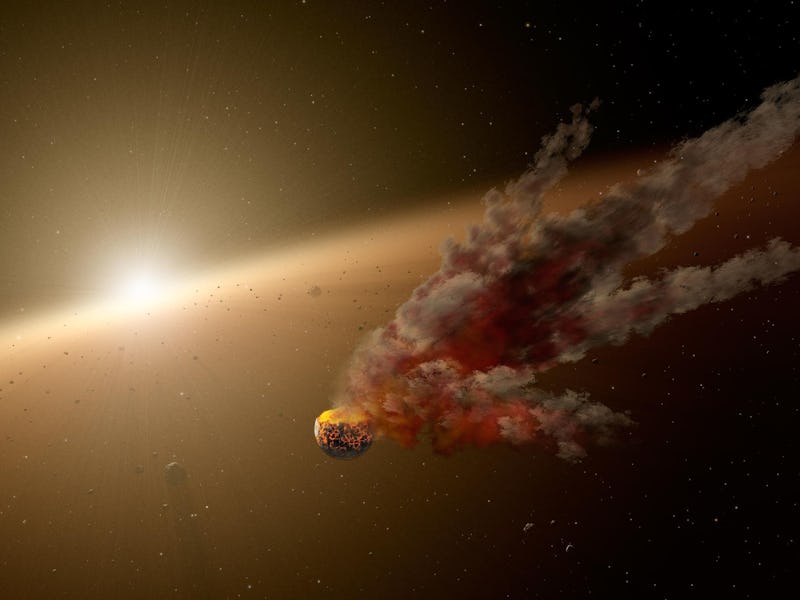Scientists Are Racing to Solve the "Alien Megastructure" Mystery
Is the dimming on a schedule?

On Friday, scientists sounded the alarm: The rule-defying Tabby’s Star — the so-called “alien megastructure” — was officially losing light yet again.
But unlike the dramatic dimming event of two years ago, scientists are now prepared and organized to be able to figure out what the hell is going on with Tabby’s Star, thanks to the leadership of its namesake, Tabetha Boyajian.
Two years ago, Boyajian — now an astrophysicist at Louisiana State University — analyzed month’s-old data from NASA’s Kepler telescope, which has its eye trained on thousands of stars in a specific part of the universe. One star, KIC 8462852, behaved like no other. At one point, the star lost nearly a quarter of its radiance, an inexplicable event that earned it the “alien megastructure” name. Since the discovery, the star continues to flummox scientists. Although a number of decent theories have emerged, scientists have been eagerly waiting for Tabby’s Star to begin dimming again, giving them an opportunity to observe it as the darkening events unfold.
“It’s critical to keep an eye on it, stay on our toes, and see what comes,” Boyajian told Inverse.
The initial dip, announced on Friday, showed a three percent drop in radiance – which is quite a bit. If alien observers 1,300 light-years away from Earth were to watch our sun lose three percent of its radiance, something the size of Jupiter would have to obstruct the sun’s light.
Throughout the weekend, astronomers around the world observed the erratic star and sent their data to Boyajian, the ad-hoc expert for the star-watching operation. “This is the central clearing house for all the observations coming in,” she says.
Two NASA images of Tabby's Star, taken in Infrared (right) and UV. The star is located 1,300 light years from Earth.
The assumption is that something with a lot of mass is blocking out a considerable portion of Tabby’s light – perhaps a group of orbiting comets, a giant mess of planetary leftovers, or (probably unlikely) an alien superstructure that intelligent beings use to harness the star’s energy. To find out, scientists are looking at the spectrums of light coming from Tabby’s Star, because light is manipulated as it travels through different things, like expansive bodies of gas or hot cosmic dust. Boyajian hopes that these observations will reveal important insights about what this obstructing matter is, along with its temperature and density.
Although there are compelling ideas about what might be blocking the light, Boyajian doesn’t yet favor any particular hypothesis. “At this point I’m keeping an open mind,” she says. “We’re trying to stay responsible about not drawing any early conclusions.”
As of Monday, May 22, the three percent dip ended, as shown in the graph below, tweeted by Jason Wright, an astrophysicist at Penn State University. But, explains Boyajian, the previous dimming events came in clusters, so there’s a “good possibility that another event or dip will happen.”
Although the new activity just began, some scientists propose that the dimming events may keep to a schedule. The earlier Kepler data, examined by Boyajian, showed that the dips might occur around every two years. “It’s suggestive of something that is periodically dimming the star – perhaps something bound to the star,” says Brian Metzger, an astrophysicist at Columbia University.
In January, Metzger published a study proposing that an Earth-sized planet or moon got kicked a bit too close to Tabby’s Star, allowing Tabby to shred off its surface and mantle. Now, that big messy pile of planetary debris could be orbiting Tabby’s Star on a pretty consistent basis, periodically blotching out a significant amount of its light.
If so, scientists using infrared telescopes should be able to find some evidence of this hot debris, especially when it passes close to Tabby’s Star and gets sizzled by the star’s heat. “If we see this infrared evidence it will be strong support of our model,” explains Metzger.
As for a massive Dyson sphere – an alien super-structure designed to surround and harness a star’s energy – it’s still in the running, although it’s probably in last place. A distant last.
“Technically we haven’t ruled out anything,” says Metzger. “Let’s talk about the Dyson sphere when we have all the cards on the table.”